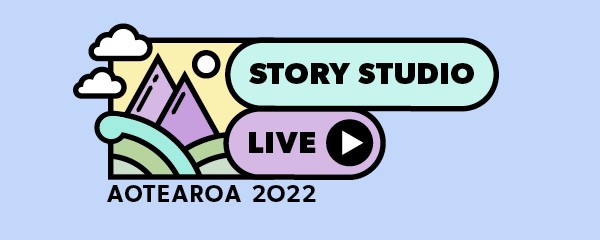Story Studio Live
Curriculum Benefits
This year, STORY STUDIO LIVE is all about Aotearoa and discovering where ākonga come from through our history and embracing te reo Māori via a huge live interactive screen. Explore the history of your town/ region’s name and other places across Aotearoa, learning the meanings behind their names.
We invite you to use this unique production as a platform to explore your local area with your ākonga.
We provide everything you need, including an MC to assist in engaging your ākonga with our performers.
This is an experience that supports learning and critical inquiry. It could be a starting point for ākonga to investigate their community history, people, and places or a landing point to conclude an inquiry process.
It links to the New Zealand Curriculum in The Arts; English; and the new Aotearoa New Zealand Histories curriculum. You will discover links to your local curriculum too as our team updates every performance to include stories drawn from each touring region.
This experience encourages ākonga to share individual stories that are relevant to them and their communities and to develop a sense of people and events that have shaped the places and spaces they live in.
Suitable for year levels 3 – 8
Detailed curriculum links:
Aotearoa New Zealand Histories
Tūrangawaewae me ti kaitiakitanga / Place and environment
Focuses on the relationships of individuals, groups, and communities with the land, water, and resources.
Rohe and local contexts
Contexts that reflect the diverse histories and experiences of the peoples of Aotearoa New Zealand. Topics and stories chosen by ākonga when inquiring into the history.
The Arts
In the arts, students explore, refine, and communicate ideas as they connect thinking, imagination, senses, and feelings to create works and respond to the works of others.
English
Making meaning of ideas or information they receive – Listening, Reading, and Viewing.
Processes and Strategies
Recognises connections between oral, written, and visual language.
Purposes and Audiences
Recognises and understands how texts are constructed for a range of purposes, audiences, and situations.
Language Features
Identifies oral, written, and visual language features used in texts and recognise their effects.
The Arts – level 1-3
As they perform, analyse, and respond to different forms of drama and theatre, they gain a deeper appreciation of their rich cultural heritage and language and new power to examine attitudes, behaviours, and values.
Understanding Drama in Context
Investigate the functions and purposes of drama in cultural and historical contexts.
Developing Practical Knowledge
Use techniques and relevant technologies to explore drama elements and conventions.
Developing Ideas
Initiate and develop ideas with others to create drama.
Communicating and Interpreting
Present and respond to drama, identifying ways in which elements, techniques, conventions, and technologies combine to create meaning in their own and others’ work.
